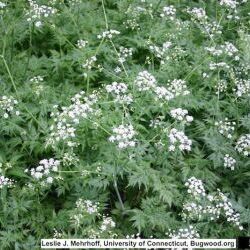
Priority: Prevent
Wild Chervil can be an annual, biennial or a short-lived perennial forb. It grows up to 1.8 tall and has small white flowers. The flowers grow in umbrella-like clusters on 2cm stalks. Each flower produces 2 seeds. It can reproduce by seed or by buds at the top of the root. The roots can extend up to 2 meters in the soil. The leaves are fern-like and have a triangular outline. They are smooth to softly hairy and the bases of the leaves clasp the hollow stems.
LRISS Category: PREVENT

Habitat & Ecology
The Fraser Valley has some large infestations of Wild Chervil along highway rights-of-way. It prefers wet conditions and disturbed soils. It grows in mid to low elevations on roadsides, pastures, forest edges and fence lines.
Impacts
It will compete with pasture and hay crops reducing its quality. It will compete with other plants for nutrients, water and can out complete other plants for space. It is well-adapted to wet areas so stream banks, river edges, ditches and wetlands are at risk for introduction and spread.
Management
This plant is difficult to control because of its deep root system. Mowing can also cause it to establish and spread. Rosettes and small plants can be hand-pulled and dug out. Mature plants, however must have all of the plant removed including the extensive root system to have any success. Please contact LRISS for all other treatment information.
References
Province of British Columbia. 2002. A Guide to Weeds in British Columbia.
